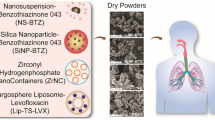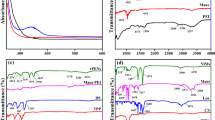ABSTRACT
Purpose
Microparticles containing solid lipid nanoparticles (SLNs) are receiving increased attention as carriers for the lung delivery of the SLNs. Thus, we aim to prepare the hybrid microparticles and thoroughly evaluate their feasibility for the pulmonary drug delivery.
Methods
The microparticles were prepared by co-spray-drying the thymopentin (TP5)-loaded SLNs with bulking agents. Thereafter, we systematically estimated the potential of the microparticles as the carriers for the pulmonary delivery of the SLNs, including the investigations of their characteristics, aerodynamic properties, pharmacokinetics and pharmacodynamics.
Results
The spherical and hollow microparticles presented a size of 4.1 ± 0.1 μm and a low tap density of 0.175 ± 0.02 g/cm3. In addition, the microparticles showed a high aerosolization efficiency (emitted dose of 98.0% ± 1.23% and respirable fraction of 51.07% ± 1.21%). Furthermore, the SLNs could be easily recovered from the microparticles without essential changes on their characteristics and the drug release behavior. The pharmacokinetic and pharmacodynamic studies suggested that, compared to i.v. TP5 solution, the bioavailability and therapeutic efficacy of TP5 were remarkably strengthened after the pulmonary administration of the microparticles.
Conclusions
Taken together, we believe the microparticles were suitable for inhalation and possesed an ample potential for the pulmonary delivery of the SLNs.





Similar content being viewed by others
Abbreviations
- AUC:
-
area under the curve
- CLSM:
-
confocal laser scanning microscope
- ED:
-
emitted dose
- EE%:
-
encapsulation efficacy
- DPI:
-
dry powder inhaler
- FITC:
-
fluorescein isothiocyanate
- HPLC:
-
high performance liquid chromatography
- i.v.:
-
intravenous injection
- mAb:
-
monoclonal Antibodies
- MRT:
-
mean residence time
- PBS:
-
phosphate buffer
- PDI:
-
polydispersity index
- RD:
-
respirable dose
- RF:
-
respirable fraction
- SD:
-
standard deviation
- SEM:
-
scanning electron microscopy
- SLNs:
-
solid lipid nanoparticles
- SOD:
-
superoxide dismutase
- TP5:
-
thymopentin
- TSI:
-
twin stage impinger
- W/O:
-
water in oil
- W/O/W:
-
water in oil in water
REFERENCES
Goldstein G, Scheid M, Boyse E, Schlesinger D, Wauwe JV. A synthetic pentapeptide with biological activity characteristic of the thymic hormone thymopoietin. Science. 1979;204:1309–10.
Clumeck N, Cran S, Van de Perre P, Lemone FM, Duchateau J, Bolla K. Thymopentin treatment in AIDS and pre-AIDS patients. Immunol Res. 1985;4:58–62.
Singh VK, Biswas S, Mathur KB, Haq W, Garg SK, Agarwal SS. Thymopentin and splenopentin as immunomodulators. Immunol Res. 1998;17:345–68.
Tischio JP, Patrick JE, Weintraub HS, Chasin M, Goldstein G. Short in vitro half-life of thymopoietin32–36 pentapeptide in human plasma. Int J Pept Protein Res. 1979;14:479–84.
Jalalipour M, Gilani K, Tajerzadeh H, Najafabadi AR, Barghi M. Characterization and aerodynamic evaluation of spray dried recombinant human growth hormone using protein stabilizing agents. Int J Pharm. 2008;352:209–16.
Ungaro F, Rosa GD, Miro A, Quaglia F, Rotonda MIL. Cyclodextrins in the production of large porous particles: development of dry powders for the sustained release of insulin to the lungs. Eur J Pharm Sci. 2006;28:423–32.
Salama RO, Traini D, Chan H-K, Sung A, Ammit AJ, Young PM. Preparation and evaluation of controlled release microparticles for respiratory protein therapy. J Pharm Sci. 2009;98:2709–17.
EXUBERA official site. http://www.exubera.com/content/con_index.jsp?setShowOn=../content/con_indx.jsp&setShowHighlightOn=../content/con_index.jsp.ed.
Yang Y, Bajaj N, Xu P, Ohn K, Tsifansky MD, Yeo Y. Development of highly porous large PLGA microparticles for pulmonary drug delivery. Biomaterials. 2009;30:1947–53.
Seville PC, Learoyd TP, Li H-Y, Williamson IJ, Birchall JC. Amino acid-modified spray-dried powders with enhanced aerosolisation properties for pulmonary drug delivery. Powder Technol. 2007;178:40–50.
Sivadasa N, O’Rourkea D, Tobina A, Buckley V, Ramtoolaa Z, Kellya JG, et al. A comparative study of a range of polymeric microspheres as potential carriers for the inhalation of proteins. Int J Pharm. 2008;358:159–67.
Tsapis N, Bennett D, Jackson B, Weitz DA, Edwards DA. Trojan particles: large porous carriers of nanoparticles for drug delivery. Proc Natl Acad Sci. 2002;99:12001–5.
Hadinoto K, Phanapavudhikul P, Kewu Z, Tan RBH. Novel formulation of large hollow nanoparticles aggregates as potential carriers in inhaled delivery of nanoparticulate drugs. Ind Eng Chem Res. 2006;45:3697–706.
Hadinoto K, Zhu K, Tan RBH. Drug release study of large hollow nanoparticulate aggregates carrier particles for pulmonary delivery. Int J Pharm. 2007;341:195–206.
Shama JO-H, Zhang Y, Finlay WH, Roaa WH, Löbenberg R. Formulation and characterization of spray-dried powders containing nanoparticles for aerosol delivery to the lung. Int J Pharm. 2004;269:457–67.
Makino K, Yamamoto N, Higuchi K, Harada N, Ohshima H, Terada H. Phagocytic uptake of polystyrene microspheres by alveolar macrophages: effects of the size and surface properties of the microspheres. Colloids Surf B Biointerfaces. 2003;27:33–9.
García-Fuentes M, Torres D, Alonso MJ. Design of lipid nanoparticles for the oral delivery of hydrophilic macromolecules. Colloids Surf B Biointerfaces. 2002;27:159–68.
Kho K, Hadinoto K. Aqueous re-dispersibility characterization of spray-dried hollow spherical silica nano-aggregates. Powder Technol. 2010;198:354–63.
Freitas C, Müller RH. Spray-drying of solid lipid nanoparticles (SLN™). Eur J Pharm Biopharm. 1998;46:145–51.
Grenha A, Seijo B, Serra C, Remuñán-López C. Chitosan nanoparticle-loaded mannitol microspheres: structure and surface characterization. Biomacromolecules. 2007;8:2072–9.
Grenha A, Remuñán-López C, Carvalho ELS, Seijo B. Microspheres containing lipid/chitosan nanoparticles complexes for pulmonary delivery of therapeutic proteins. Eur J Pharm Biopharm. 2008;69:83–93.
Gómez-Gaete C, Fattal E, Silva L, Besnard M, Tsapis N. Dexamethasone acetate encapsulation into Trojan particles. J Control Release. 2008;128:41–9.
Liu J, Gong T, Wang CG, Zhong ZR, Zhang ZR. Solid lipid nanoparticles loaded with insulin by sodium cholate-phosphatidylcholine-based mixed micelles: preparation and characterization. Int J Pharm. 2007;340:153–62.
Bosquillon C, Préat V, Vanbever R. Pulmonary delivery of growth hormone using dry powders and visualization of its local fate in rats. J Control Release. 2004;96:233–44.
Wang J, Lu WL, Liang GW, Wu KC, Zhang C-G, Zhang X, et al. Pharmacokinetics, toxicity of nasal cilia and immunomodulating effects in sprague-dawley rats following intranasal delivery of thymopentin with or without enhancers. Peptides. 2006;27:826–35.
Treitinger A, Spada C, Verdi JC, Miranda AFB, Oliveira OV, Silveira MVS, et al. Decreased antioxidant defence in individuals infected by the human immunodeficiency virus. Eur J Clin Investig. 2001;30:454–9.
Yin YS, Chen DW, Qiao MX, Lu Z, Hu HY. Preparation and evaluation of lectin-conjugated PLGA nanoparticles for oral delivery of thymopentin. J Control Release. 2006;116:337–45.
French DL, Edwards DA, Niven RW. The influence of formulation on emission, deaggregation and deposition of dry powders for inhalation. J Aerosol Sci. 1996;27:769–83.
Maury M, Murphy K, Kumar S, Mauerer A, Lee G. Spray-drying of proteins: effects of sorbitol and trehalose on aggregation and FT-IR amide I spectrum of an immunoglobulin G. Eur J Pharm Biopharm. 2005;59:251–61.
Bosquillon C, Lombry C, Préat V, Vanbever R. Influence of formulation excipients and physical characteristics of inhalation dry powders on their aerosolization performance. J Control Release. 2001;70:329–39.
Kibbe AH. Handbook of pharmaceutical excipients, London; 2000.
Souilliac PO, Middaugh CR, Rytting JH. Investigation of protein/carbohydrate interactions in the dried state. 2. Diffuse reflectance FTIR studies. Int J Pharm. 2002;235:207–18.
Tzannis ST, Prestrelski SJ. Activity-stability consideration of trypsinogen during spray drying: effect of sucrose. J Pharm Sci. 1999;88:351–9.
ACKNOWLEDGMENTS
This work was funded by the National S & T Major Project of China (Grant No: 2009ZX09310–002) and the National Science Foundation of PR China (No.30873165).
Author information
Authors and Affiliations
Corresponding authors
Rights and permissions
About this article
Cite this article
Li, YZ., Sun, X., Gong, T. et al. Inhalable Microparticles as Carriers for Pulmonary Delivery of Thymopentin-Loaded Solid Lipid Nanoparticles. Pharm Res 27, 1977–1986 (2010). https://doi.org/10.1007/s11095-010-0201-z
Received:
Accepted:
Published:
Issue Date:
DOI: https://doi.org/10.1007/s11095-010-0201-z




